Neighborhoods Buenos Aires
The charm of Buenos Aires for many tourists is the allure of the 48 districts, or neighborhoods, known as barrios. There are many diverse neighborhoods, such as La Boca, an Italian neighborhood with brightly painted houses; San Telmo, with its flea markets and tango venues; and Palermo, filled with parks and many great restaurants and bars. Each district is highly individualized with its own characteristic colors and styles. Buenos Aires has no defining monument that serves as a focal point. Instead, it has many small details, events, and interactions, each with a different shade and character. Skyscrapers loom over 19th-century Victorian houses while tango dancers sway outside dusty antique shops. Below find a brief description of some of the most populated and visited barrios of Buenos Aires.
Microcentro
The neighborhoods of San Nicolás and Montserrat are collectively known as the micro center. The center of Buenos Aires is the busiest quarter, with close connections to tourist attractions such as the Obelisk, Avenida de Mayo, Plaza de Mayo, Florida Shopping Street, Congress, and Plaza San Martin. This area contains the business and financial district and many shops, restaurants, cinemas, parks, plazas, monuments, and government buildings. Here, Eva Peron fans can visit the Casa Rosada in the Plaza de Mayo, from which Evita made many of her famous speeches.
La Boca
La Boca is located in the southeast of the city. It is a colorful neighborhood full of European flavor, with brightly painted houses illustrating every color of the rainbow. La Boca is the home of many Italian immigrants and their hastily erected tin houses which have now formed both a residential area and a tourist attraction. La Boca is also known throughout the sporting world as the birthing place of one of South America’s best football clubs, the Boca Juniors. The use of color and the general artistic tradition of this neighborhood were heavily influenced by one of Argentina’s most famous artists, Benito Quinquela Martin. He used his art as a form of political and social protest. Other attractions in La Boca include the Museo de Cera wax museum and of course the iconic El Caminito, the world famous traditional alley and street museum. El Caminito is a popular pedestrian street in Buenos Aires, one of the most popular tourist attractions in Buenos Aires due to its colorful houses and history and cultural meaning.
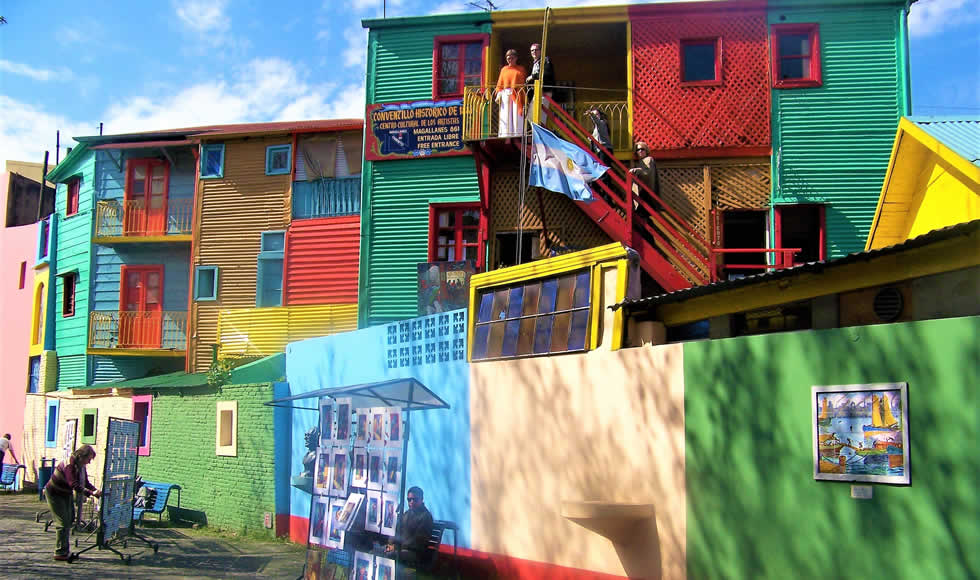
Buenos Aires La Boca
San Telmo
San Telmo is a historic neighborhood in Buenos Aires, located south of the city center. It is known for its bohemian atmosphere, colorful streets, and colonial architecture.
The neighborhood was established in the 17th century as a residential area for the city's wealthy families; later, it became a working-class neighborhood and a center of immigration in the 19th century. Today, San Telmo is home to a diverse population of artists, writers, musicians, and young professionals.
One of the main attractions of San Telmo is its Sunday antique market, which takes place in Plaza Dorrego and features a wide range of vintage and antique items, including furniture, books, jewelry, and artwork. The market is a popular destination for tourists and locals, and cafes, restaurants, and street performers surround it.
Other notable attractions in San Telmo include the Parque Lezama, a large park with a historic mansion and a museum of Argentine history; the Iglesia de San Pedro Telmo, a 17th-century church known for its ornate baroque architecture; and the Pasaje Defensa, a narrow alley lined with art galleries, boutiques, and cafes.
San Telmo is home to many cultural centers, including the Centro Cultural Borges, which hosts art exhibitions, film screenings, and theater performances; the Usina del Arte, a modern cultural center with a concert hall and exhibition space; and the El Zanjon de Granados, a restored 19th-century mansion that offers guided tours of its underground tunnels and historical artifacts.
To get to San Telmo, you can take the subway to the Plaza de Mayo station (Line A) or the San Juan station (Line C). Alternatively, you can take a bus or a taxi from other parts of the city.
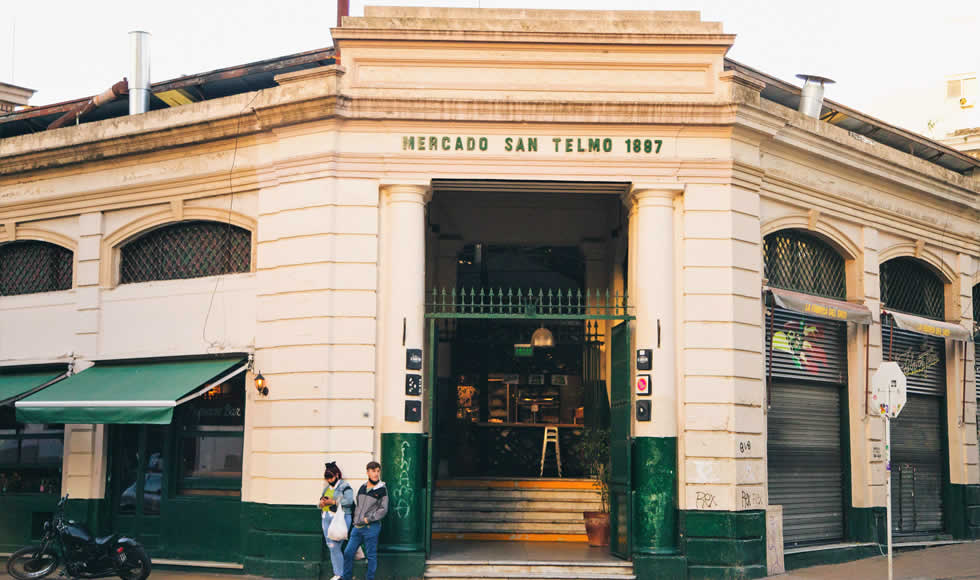
San Telmo Market
Palermo
Palermo is a trendy and bustling neighborhood in Buenos Aires, located in the northeast part of the city. It is known for its vibrant nightlife, fashionable boutiques, and expansive parks.
Palermo is divided into several sub-neighborhoods, including Palermo Hollywood, Palermo Soho, and Palermo Chico. Palermo Hollywood is known for its restaurants, bars, and nightclubs. In contrast, Palermo Soho is known for its boutique shops, cafes, and street art. Finally, Palermo Chico is a more upscale area with luxurious homes and embassies.
One of the main attractions in Palermo is the Bosques de Palermo, a large park with lakes, gardens, and walking trails. The park also features the Jardín Japonés, a Japanese garden with a tea house and a koi pond, and the Planetario Galileo Galilei, an observatory with interactive exhibits and a digital projection system.
You can find many museums in Palermo, including the Museo de Arte Latinoamericano de Buenos Aires (MALBA), which features a collection of contemporary Latin American art; the Museo Evita, which showcases the life and legacy of Eva Perón; and the Museo Nacional de Arte Decorativo, which displays a collection of decorative arts from around the world.
Palermo has a vibrant food scene, with a wide range of restaurants and cafes offering local and international cuisine. The neighborhood also has many bars and clubs, making it a popular destination for nightlife.
To get to Palermo, you can take the subway to one of several stations on Line D, such as Scalabrini Ortiz or Plaza Italia. Alternatively, you can take a bus or a taxi from other parts of the city.
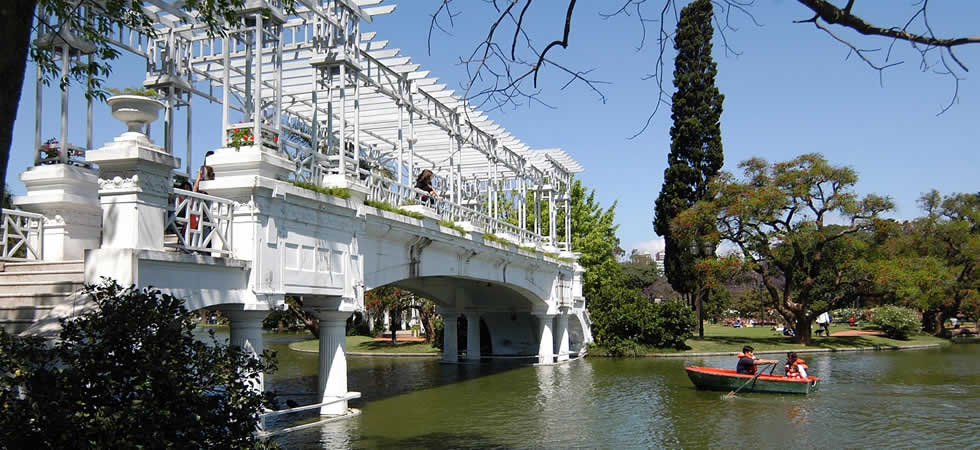
Bosques de Palermo Buenos Aires
Recoleta
Recoleta is a historic and elegant neighborhood in Buenos Aires, known for its upscale shops, restaurants, and cultural attractions. It is named after the Recoleta Cemetery, which is located within the neighborhood and is one of the most famous cemeteries in the world.
The Recoleta Cemetery is the final resting place of many important figures in Argentine history, including Eva Perón. The cemetery is known for its elaborate mausoleums and ornate sculptures and is a popular tourist attraction.
Another popular attraction in Recoleta is the Museo Nacional de Bellas Artes, which houses an Argentine and international art collection, including works by Van Gogh, Monet, and Rembrandt. The museum is located in a historic building, and admission is free.
Recoleta has several parks and green spaces, including the Plaza Francia and the Parque Thays, which feature rose and botanical gardens. The neighborhood has a vibrant cultural scene, with many theaters, galleries, and music venues. It is also known for its luxury hotels and restaurants, including the famous La Biela cafe, a meeting place for intellectuals and politicians for over a century.
To get to Recoleta, you can take the subway to the Recoleta station on Line D or take a bus or a taxi from other parts of the city. The neighborhood is also within walking distance of popular tourist attractions like the Teatro Colón and the Obelisk.
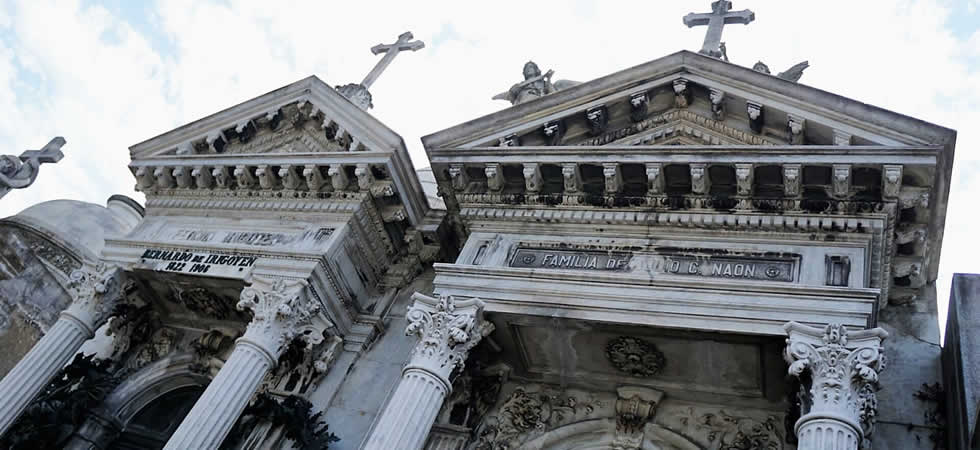
Cemetry Recoleta Buenos Aires
Retiro
Retiro is a central neighborhood located in Buenos Aires, Argentina. It is known for its large transportation hub, as the Retiro bus terminal and the Retiro train station are located within the neighborhood. Retiro is also home to several important government buildings, including the Presidential Palace and the National Congress.
One of the main attractions in Retiro is the Plaza San Martin, a large park near the Retiro train station. The park features a statue of General San Martin, one of the heroes of Argentine independence, and several other monuments and fountains.
Retiro is also known for its luxury hotels and high-end shopping, with several upscale stores and boutiques in the area. In addition, the Patio Bullrich shopping center, located on the edge of the neighborhood, features designer brands and international retailers.
The neighborhood has many architectural styles, including grand old mansions, Art Deco buildings, and modern skyscrapers. Retiro also has several museums, including the Museum of Foreign Debt, which explores Argentina's economic history, and the Museum of Contemporary Art, which showcases works by Argentine and international artists.
To get to Retiro, you can take the subway to the Retiro station on Line C or take a bus or a taxi from other parts of the city. The neighborhood is also within walking distance of popular tourist attractions, such as the Obelisk and the Teatro Colon.
Villa Crespo
Just southwest of Palermo, Villa Crespo hasn't quite been gobbled up by Palermo — yet. The barrio is a great place to stay or stroll about. Several other popular neighborhoods border the neighborhood, including Palermo, Almagro, and Caballito.
Villa Crespo is known for its vibrant cultural scene, eclectic mix of restaurants and cafes, and lively nightlife. One of the most popular areas of the neighborhood is the commercial district along Avenida Corrientes, which is lined with shops, restaurants, and theaters.
One of the main attractions of Villa Crespo is the Mercado de las Pulgas, an indoor flea market known for its vintage and antique goods. The market is a popular destination for locals and tourists alike and is a great place to find unique souvenirs and gifts.
Another notable landmark in Villa Crespo is the Parque Centenario. This large public park is home to a lake, a cultural center, and a planetarium. In addition, the park is popular for jogging, picnicking, and outdoor concerts and events.
Villa Crespo is well-connected to other parts of the city by public transit. The neighborhood is served by several subway lines, including the B and D lines, and several bus lines that run through the area.
Overall, Villa Crespo is a dynamic and diverse neighborhood that offers something for everyone. So whether you're interested in shopping, dining, or simply soaking up the local culture, Villa Crespo is worth a visit.
Almagro
Almagro is known for its tree-lined streets, beautiful parks, and historic architecture. One of the neighborhood's main attractions is the landmark Italian Hospital, founded in 1887 and still operates today. The Hospital's impressive neo-Renaissance building is considered one of the most beautiful examples of early 20th-century architecture in Buenos Aires.
Another notable landmark in Almagro is the Abasto Market, a vibrant indoor market that sells fresh produce, meat, and fish. The market is housed in a former Art Deco theater and is a popular destination for locals and tourists alike. The neighborhood is also home to several parks and green spaces, such as the Plaza Almagro, which features a beautiful fountain and is a popular spot for picnics and outdoor gatherings.
Almagro is well-connected to other parts of the city by public transit. The neighborhood is served by several subway lines, including the A, B, and H lines, as well as several bus lines that run through the area. Overall, Almagro is a charming and picturesque neighborhood that offers a glimpse into Buenos Aires' rich history and culture. Whether you're interested in architecture, food, or simply soaking up the local atmosphere, Almagro is definitely worth a visit.
Puerto Madero
Puerto Madero is a waterfront neighborhood in Buenos Aires, Argentina, located on the city's east side along the Rio de la Plata river. Once a rundown port area, Puerto Madero has undergone extensive redevelopment recently and is now a popular destination for ex-pats and young professionals.
The neighborhood is known for its modern architecture, with many sleek and stylish buildings designed by renowned architects such as Santiago Calatrava and Norman Foster. One of the most iconic landmarks in Puerto Madero is the Puente de la Mujer (Bridge of the Woman). This striking pedestrian bridge spans the port's central canal.
Puerto Madero is also home to several museums, such as the Fortabat Art Collection, which showcases works by Argentine artists and European masters, and the Museum of Modern Art, which has a collection of contemporary art from around the world.
The neighborhood is a popular destination for foodies, with many high-end restaurants, trendy bars, and cafes lining the streets. There are also several parks and green spaces, such as the Reserva Ecológica Costanera Sur, a nature reserve that provides apeaceful retreat from the bustling city.
To get to Puerto Madero, you can take the subway to the nearby Retiro or Plaza de Mayo stations or take a bus or taxi from other parts of the city. The neighborhood is a great place to explore on foot, with many scenic walking and biking trails along the waterfront. Overall, Puerto Madero is a must-visit destination for anyone traveling to Buenos Aires. With its stunning architecture, cultural attractions, and delicious cuisine, it is a vibrant and exciting neighborhood that embodies the city's spirit.
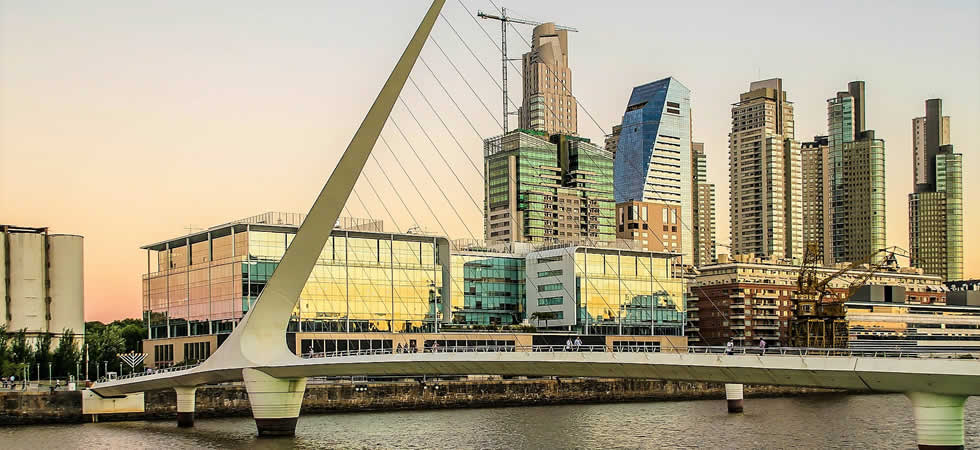
Puerto Madero Buenos Aires
Las Canitas
Las Cañitas is a trendy neighborhood in the Palermo district of Buenos Aires, Argentina. It is known for its lively atmosphere, chic restaurants, bars, and cafes, and its popularity among young professionals and ex-pats.
The neighborhood was once a military base but is now a bustling commercial and
residential area. The streets are full of boutique shops, upscale restaurants, and trendy cafes. It is also home to several parks, such as the Parque Las Heras, which is popular among joggers and outdoor enthusiasts.
One of the main attractions in Las Cañitas is the Campo Argentino de Polo, a world-class polo stadium hosting several international tournaments annually. The stadium is located in the heart of the neighborhood and is a must-visit for sports fans.
Las Cañitas is also home to several museums and cultural institutions, such as the Museo Nacional de Arte Decorativo, which houses an extensive collection of decorative arts and furniture, and the Planetario Galileo Galilei, an interactive museum dedicated to astronomy.
To get to Las Cañitas, you can take the subway to the nearby Palermo station or take a bus or a taxi from other parts of the city. The neighborhood is a popular destination for foodies and nightlife lovers. It has several bars and clubs that stay open late into the
night. So whether you're looking for a gourmet meal, a stylish cocktail, or a
lively night out, Las Cañitas has something for everyone.
Barracas
Barracas is a neighborhood located in the southern part of Buenos Aires, Argentina. It is known for its historic architecture, colorful street art, and thriving arts scene. The neighborhood was once an industrial hub, but it has recently transformed into a vibrant cultural center.
One of the main attractions in Barracas is the Pasaje Lanín, a colorful street lined with murals and art installations. The street is a popular destination for street art lovers and photographers.
Another popular spot is the Casa de la Cultura. This historic building now houses art exhibitions, theater performances, and other cultural events. Barracas is also home to several landmark buildings, such as the Santa Felicitas Church, a Gothic Revival masterpiece that was built in the late 19th century, and the El Obrero restaurant, which has been serving traditional Argentine cuisine since 1954.
The neighborhood has various architectural styles, including Spanish colonial, Italianate, and Art Deco. It has several parks and green spaces, such as the Parque Lezama and the Reserva Ecológica Costanera Sur.
To get to Barracas, you can take the subway to the nearby Constitución station or take a bus or a taxi from other parts of the city. Barracas is a popular destination for artists, musicians, and creative types and has several galleries, studios, and performance spaces. It is also known for its lively nightlife, with several bars and clubs open late into the night.
Belgrano
Belgrano is a residential neighborhood located in the northern part of Buenos Aires, Argentina, next to Palermo (Hollywood). Belgrano is known for its extensive parks, traditional architecture, and quiet, upscale atmosphere. The neighborhood is named after Manuel Belgrano, one of the heroes of Argentine independence.
One of the main attractions is the Barrancas de Belgrano, a large park along the banks of the Rio de la Plata. The park features several sculptures, monuments, and a weekend artisan fair. Another popular park in the area is the Parque de la Memoria. This memorial park honors the victims of Argentina's military dictatorship.
Belgrano is home to several historic buildings and landmarks, such as the Belgrano C railway station, the Church of the Immaculate Conception, and the Museo Larreta, a mansion-turned-museum showcases Argentine art and history. The neighborhood has various architectural styles, including Spanish colonial, Art Deco, and modern high-rises. Belgrano is known for its tree-lined streets and spacious plazas, such as Plaza Manuel Belgrano and Plaza Castelli.
To get to Belgrano, you can take the subway to one of the neighborhood's several stations on Line D or take a bus or a taxi from other parts of the city. Belgrano is a popular neighborhood for families and professionals and has several excellent schools, restaurants, and shops.
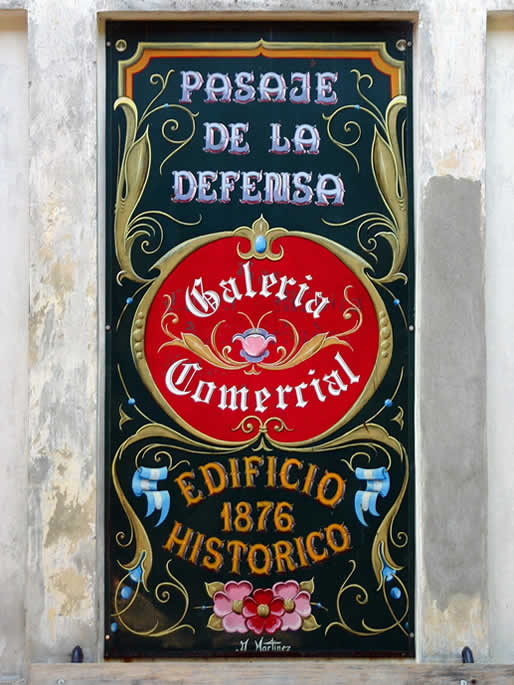
San Telmo Pasaje Defensa